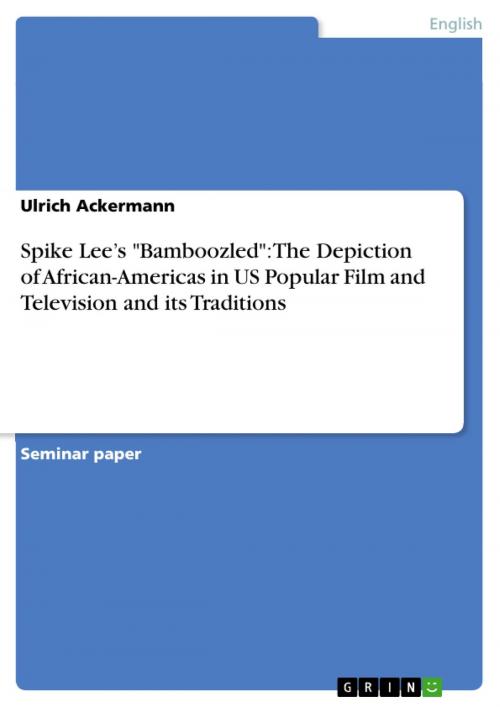Spike Lee's 'Bamboozled': The Depiction of African-Americas in US Popular Film and Television and its Traditions
Fiction & Literature, Literary Theory & Criticism, British| Author: | Ulrich Ackermann | ISBN: | 9783640557097 |
| Publisher: | GRIN Publishing | Publication: | March 8, 2010 |
| Imprint: | GRIN Publishing | Language: | English |
| Author: | Ulrich Ackermann |
| ISBN: | 9783640557097 |
| Publisher: | GRIN Publishing |
| Publication: | March 8, 2010 |
| Imprint: | GRIN Publishing |
| Language: | English |
Seminar paper from the year 2007 in the subject English Language and Literature Studies - Literature, grade: 2,0, University of Freiburg, course: Hauptseminar The Rise of the Entertainment Industry, language: English, abstract: Throughout their history in the United States, African-Americans had never been in charge of their own image. When in Kentucky in 1928, Thomas 'Daddy' Rice, a white man who performed in black-face 'Jim Crow', a song that he had heard before in the South from a black performer, a new genre was born: the minstrel show, a white imitation of black culture. In his movie Bamboozled (2000), Spike Lee confronts us with the question, if these racist nineteenth century depictions of African Americans still exist today in contemporary popular media. In this case we have to ask the question of responsibility for these representations: In the 1990s 340 billion dollars had been spent on media and entertainment in the United States. The entertainment industry today has become the fastest increasing factor of economy. Since the 1970s television is the largest and most influential entertainment medium in North America and occupies a crucial space in practices of everyday life, 'where important social encounters and cultural transformations are possible.' The concept of 'seeing is believing' obviously is a major factor here.' A majority of Americans only came to know and understand the American racial order through media representations of the black ethnic other. This research paper will try to give some proof of the historical continuity of the stereotypical racist representations of African Americans from the days of minstrelsy and vaudeville until today.
Seminar paper from the year 2007 in the subject English Language and Literature Studies - Literature, grade: 2,0, University of Freiburg, course: Hauptseminar The Rise of the Entertainment Industry, language: English, abstract: Throughout their history in the United States, African-Americans had never been in charge of their own image. When in Kentucky in 1928, Thomas 'Daddy' Rice, a white man who performed in black-face 'Jim Crow', a song that he had heard before in the South from a black performer, a new genre was born: the minstrel show, a white imitation of black culture. In his movie Bamboozled (2000), Spike Lee confronts us with the question, if these racist nineteenth century depictions of African Americans still exist today in contemporary popular media. In this case we have to ask the question of responsibility for these representations: In the 1990s 340 billion dollars had been spent on media and entertainment in the United States. The entertainment industry today has become the fastest increasing factor of economy. Since the 1970s television is the largest and most influential entertainment medium in North America and occupies a crucial space in practices of everyday life, 'where important social encounters and cultural transformations are possible.' The concept of 'seeing is believing' obviously is a major factor here.' A majority of Americans only came to know and understand the American racial order through media representations of the black ethnic other. This research paper will try to give some proof of the historical continuity of the stereotypical racist representations of African Americans from the days of minstrelsy and vaudeville until today.














![Cover of the book The basics of teamwork [Hausarbeit plus Präsentation] by Ulrich Ackermann](https://www.kuoky.com/images/2003/april/300x300/9783638181020-HqTK_300x.jpg)
